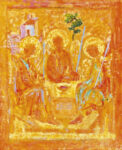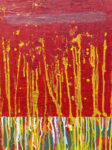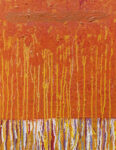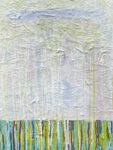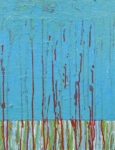IT WAS APRIL 2020, in the first months of the Covid lockdown, when my wife and I realized we’d be working from home and supporting our three kids, aged three to nine, “going” to school on Zoom from our three-bedroom flat. We made the best of it. In the morning sunshine, we’d walk around the block, and in the evening, we’d go on bike rides in the cemetery. It seemed fitting: On the news, the number of people dying was steadily climbing.
We found ways to support one another. We agreed that I’d go to the art studio on Wednesday evenings at eight-thirty after I helped put the kids to bed. It didn’t take long for me to realize that flinging paint around in a rushed, anxious state of mind doesn’t lead to art. The results were abysmal.
Meanwhile, logging in to our Sunday church service by Zoom wasn’t cutting it either. My soul was languishing. Sensing that I needed something ancient to anchor me in this contemporary crisis, I googled lectio divina on zoom. To my surprise, a group in California was meeting weekly on Wednesday evenings at six-thirty. Thanks to the time difference, I could join from my studio at eight-thirty. My soul leapt.
My studio would become a sanctuary. I joined the ragtag group of six or seven people who gathered each week to sit in silence on Zoom and listen to Scripture together. There was evening; there was morning: a new day.
I stopped painting. I stopped making art. I just sat there in my studio. I thought, I’m an artist who doesn’t make art. I told God, This is my sacrifice of praise. We’d sit in silence for thirty minutes, then say the Lord’s Prayer and enter into a time of lectio divina, usually meditating on a Gospel passage or a psalm.
Silence is a deprivation all its own. It is a vast desert where one’s chitchat and puffed-up sense of self go to die. By fasting from myself, I gave my soul a fighting chance to pass through the empty desert and enter the distant garden. As I slowed down and listened to the poetry of Scripture, my soul found the rhythm of being beloved. It was lush, green nourishment. The word of God was a feast all its own.
Centering prayer is an ancient Christian practice of resting in God’s presence. It can be both ravishing and slow. At first, my mind was all over the place, but as I continued to meet with the group, I found myself calmer at work and at home, attended by an oceanic peace, even amid the chaos of trying to keep up with endless emails in one room while attending to my children’s meltdowns in the other. I sensed God’s presence in difficult moments. The silence allowed my soul to breathe.
Rather than imitate the traditional iconographic style, I looked to Eastern Orthodox iconographers pray as they “write” icons. Their work is an act of devotion. I adopted a similar discipline: silence, prayer, Scripture, then I’d pick up the brush. In the studio, my heart became a house of prayer. Pigments found their harmonies and began to sing. The yellows and oranges, reds, and turquoises, were stardust. In that divine dance of creation, I encountered the light that shines in the darkness and the still, small voice that speaks in the silence. Painting became prayer, or perhaps prayer became painting. There was a flow and a vision of oneness. There was evening; there was morning: a new day.
The first painting that emerged from this time was a small, shimmering version of the icon The Hospitality of Abraham, also known as The Trinity, originally painted by fourteenth-century iconographer-theologian Andrei Rublev. Rather than imitate the traditional iconographic style, I looked to the poetic work of Pierre Bonnard, a thoughtful colorist. And where Rublev’s icon is over four feet tall, this intimate painting, at only ten by eight inches, was not much larger than the chamber of my heart. It was a painting I could love, a painting that could hold my heart. I wasn’t alone.
I continued in this rhythm: sitting in silence, listening to Scripture, then mixing a color and laying it down. The subsequent paintings were densely layered canvases that captured the movements of contemplation: paying attention, being present, then letting go. Along the bottom of each painting, the drips were left to run down, like thoughts allowed to arise in the mind and then pass on. Each color expressed a feeling, a state of being, then was let go. A soft pink invited my soul to rest in my beloved’s embrace, to lets its anguish and joy be contained. I’d close my eyes.
God prays within us, and the paint runs down in the present moment.




